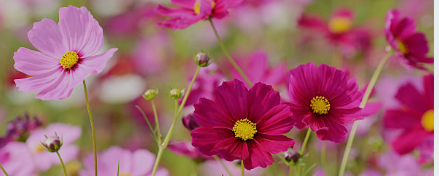
The Ultimate Guide to Growing Cosmos – planting, care and support tips
Lesley Ann Sandbach
I love Cosmos! They are the most versatile of the annuals I grow: they look lovely woven through a border where their daisy-like heads lighten the feel of the planting; pollinators love them; they make wonderful cut flowers, long lasting and prolific and, even better, they are also happy in large containers as long as they are given a little support such as stakes or semi-circular supports . They are available in a wide variety of colours including the delicate ‘Apricotta’ and the velvety chocolate cosmos.

What are cosmos?
These easy-to-grow annuals, which are related to asters, have wide, daisy-like faces that sit over fern-like foliage but are more robust than they look. When I first started growing them, the colour palette was limited to white, pink and crimson but, in recent years, the range of colour and shapes has exploded. First came the ‘shell’ shapes where the petals curved in on themselves to give a paler outer shell with the true colour inside and with them came the doubles (I am generally more fond of single flowers than double ones but ‘Cranberry Clicks’ won me over – a double cosmos the colour of cranberries). Recently, a range of cosmos in the most delicate champagne, apricot and shell pinks has been available. This year I am growing Cosmos bipinnatus ‘Apricotta’ from seed. This variety and the other pastel shades are readily available from a number of reliable suppliers as seeds or plugs.


How do I grow cosmos: planting, care and support
Cosmos can be sown either directly into the ground where they are to flower or into pots and modules (as the new varieties are expensive seed, I shall grow them in pots indoors to get them off to a good start before I offer them to the slugs outside!)
The seeds are long and narrow but easy to handle. Sow two or three in a small pot in moist, well drained compost (I use potting grit mixed with John Innes compost for seeds – nothing is more fatal to seedlings than sitting in cold, wet soil) and then cover with potting grit or vermiculite
Place the pots on a bright window sill or, ideally, in an unheated greenhouse or cold frame, once the danger of frost has passed
The seeds germinate very quickly, arching their way out of the potting medium; keep the compost moist but not wet
Once the seedlings have formed three pairs of leaves, pinch out the tops to produce more bushy plants and more flowers (particularly if they are to grow in containers)
Once all danger of frost has passed, plant them out in a sunny position
Cosmos are generally disease-free but slugs and snails do love the young plants and I fear that these pests have survived the winter in great numbers so do protect young plants with environmentally-friendly pellets or other slug barriers as you plant them out
Keep them well watered until they are established and, as they grow, feed them with a balanced liquid fertilizer
Some of the taller varieties will benefit from a stake or a semi-circular support to keep them upright
Keep deadheading to encourage flowers
At the end of the season collect a few seeds from spent flowerheads that have dried and keep them to sow the following season





There is a tender perennial cosmos, Cosmos atrosanguineus, known as the chocolate cosmos. It produces dark, velvety flowers that have a faint smell of vanilla and chocolate. Unlike annual cosmos, it grows from tubers and should be treated like a dahlia and lifted to overwinter indoors or mulched heavily overwinter. I have never managed to get it through the winter but it is a lovely variety so it is worth a little extra effort.
I intend to make a big feature of cosmos this year, using Cosmos bipinnatus ‘Purity’ in the terrace border where I use white as a base colour and Cosmos bipinnatus ‘Apricotta’ in the long border where oranges and purples are the feature colours.
Troubleshooting FAQs
My cosmos seedling are leggy. What should I do?
Cosmos grow fast so don’t sow them too early and make sure they have plenty of light to encourage sturdy growth. If they do get leggy, prick them out into a slightly larger container planting a little deeper than they were and pinch out to encourage bushier growth
When should I pinch out cosmos plants?
Pinch out the centre of the seedling when it has 3 pairs of leaves; this will produce a stronger, more bushy plant with more flowers
When should I transplant cosmos seedlings
Once the plant has been pinched out it can be moved; move it into a container or border planting it at the same depth as it was in the seed tray. If several seedlings have clumped together, gently tease them apart and plants in twos and threes
My cosmos are growing well but why aren’t they producing flowers?
If your plants are tall and sturdy but producing no blooms, they may have been fed with a fertilizer that has too much nitrogen. There are fertilizers such as Vitax Q4 or Growmore that are intended to promote flowering
Will my cosmos come back next year?
Cosmos are not hardy and frost will kill the plants. You can collect seed from the plants at the end of the season but, if they are not kept overwinter in good conditions, they may not germinate
